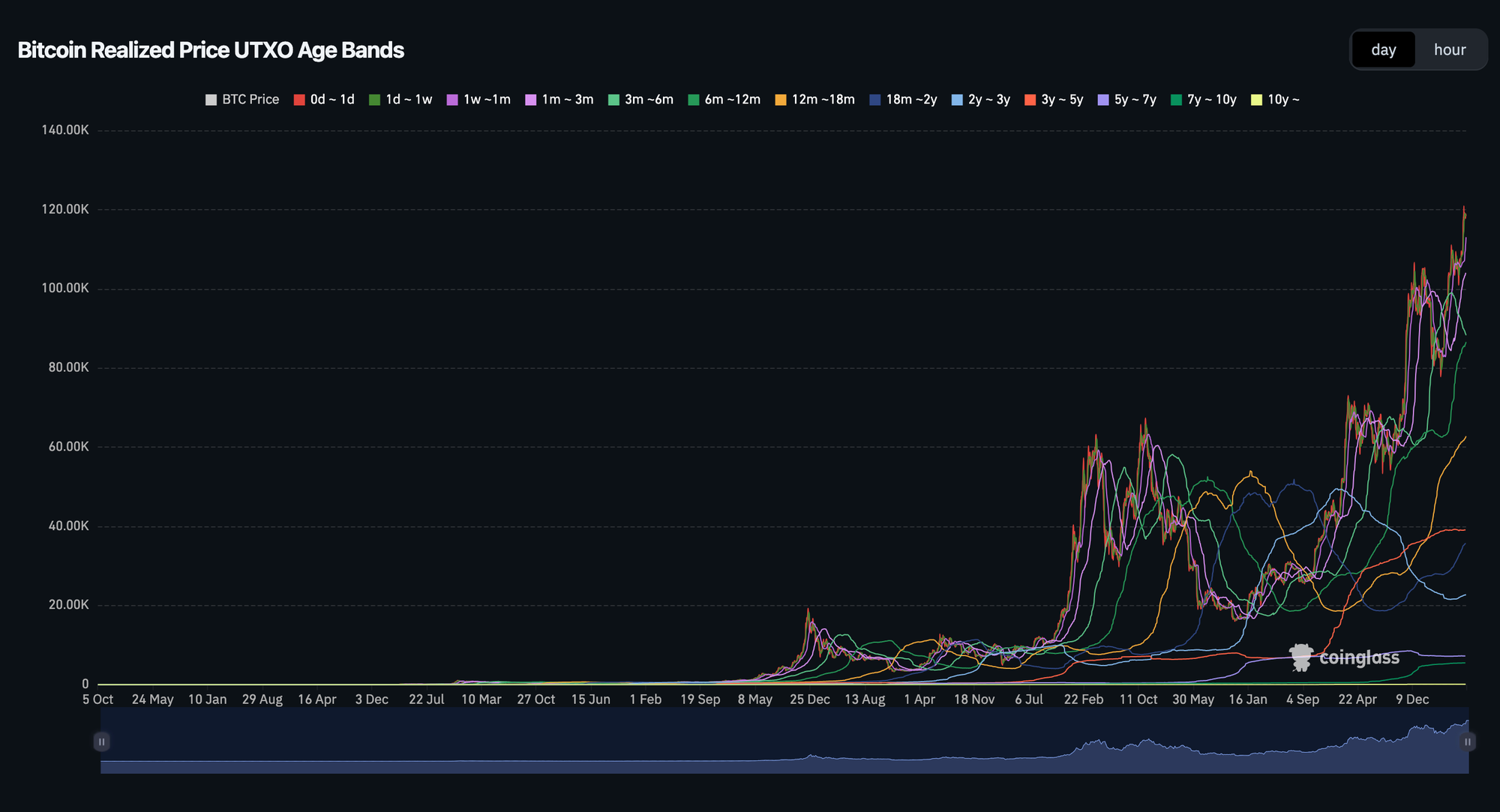What Is URPD?
URPD stands for UTXO Realised Price Distribution. It shows how much of the supply last moved at each price level. Think of it as a histogram of cost basis. Tall bars mark price zones where significant capital changed hands, which often act as support or resistance when revisited.
How Is URPD Built?
- Each UTXO has a last-moved price.
- Group UTXOs into price bins.
- Sum the coin amount per bin to show how much supply realised its cost basis there.
- The result is a distribution across price levels rather than a time series.
URPD does not predict price. It maps where cost basis clusters exist so you can prepare for how the market may behave when those levels return.
Why URPD Matters
- Reveals pinned capital. Levels with large realised volume tend to attract reaction.
- Distinguishes newly formed bases from thin zones.
- Complements behaviour tools by showing where absorption is likely.
Reading the Attached Chart
The image below is a UTXO Age-Band Realised Price panel from Coinglass. It is a time series companion to URPD. Each line tracks the realised price for a specific age cohort. Together they show how cost basis migrates through time and which cohorts are driving resets.

This chart plots realised price for each age cohort so you can see cost-basis migration, crossovers, and where pressure sits after rallies or pullbacks.
What this panel shows and how to read it
- Younger bands rising quickly signal that recent buyers have reset their cost basis higher. After strong advances this often expands the 1m–3m and 3m–6m lines.
- STH stress vs relief appears when price dips back toward the 1–3m or 3–6m realised price lines. If price holds above them, pullbacks are being absorbed.
- Older bands moving such as 2–3y, 3–5y, 5–7y indicate meaningful activity from seasoned supply. When these rise together it often reflects redistribution from older holders into newer hands.
- Crossovers between mid-age bands highlight rotation. For example, a 6–12m line crossing up through 3–6m suggests last year’s buyers have repriced higher.
- Flat very old bands like 7–10y or 10y imply dormancy. That usually supports trend strength because the deepest holders are not providing extra supply.
Use this panel to infer which cohorts will be most sensitive if price revisits their realised price. Then cross-check with a URPD histogram to confirm how much supply actually sits at those levels.
Practical Use With Confluence
- URPD histogram for level sizing: where the biggest pockets of cost basis sit.
- Realised Price bands for the ladder: Market, LTH, STH.
- SOPR and Realised PnL for behaviour at those levels: absorption or distribution.
- Dormancy or CDD to validate whether older coins are driving changes in the age-band lines.
Common Pitfalls

- Mixing the two views. URPD is distribution by price, the attached panel is age-band realised price over time. Use both, but read them for what they are.
- Treating levels as guarantees. Large clusters improve the chance of reaction, not certainty.
- Ignoring cohort context. A revisit to a level dominated by short-term holders trades differently to one dominated by multi-year holders.
A Simple Workflow You Can Reuse
- Open a URPD histogram to mark the largest cost-basis clusters.
- Open the UTXO age-band realised price panel and note which cohorts would be affected if those levels are revisited.
- Check aSOPR and Realised PnL around those revisits for absorption or distribution.
- Cross-check Market, LTH, STH Realised Price for the ladder context.
- Decide: strong base with supportive cohorts, or thin pocket with risk of slippage.
FAQ

Why use age-band realised price with URPD?
URPD shows where supply is clustered. Age-band realised price shows which cohorts will feel it. Together they explain reaction quality at key levels.
Which timeframe is best for the age-band panel?
Daily for detail, weekly for cycle context. Use the same timeframe when comparing to price.
Does a large URPD bar always hold?
No. It improves odds of reaction. Behaviour metrics tell you if the level is being absorbed or distributed.
If this helped you spot cost-basis clusters and who they belong to, join Alpha Insider for URPD maps, liquidity pockets, and weekly timing windows. Fewer mistakes, cleaner execution, more conviction.
The Markets Unplugged members get:
➡️ Kairos timing windows to plan entries before the crowd moves
➡️ A full DCA Targets page with levels mapped for this cycle
➡️ Exclusive member videos breaking down charts in plain English
➡️ A private Telegram community where conviction is shared daily
➡️ A dedicated Bitcoin On-Chain Analysis page with regularly updated analysis and monthly reports (MVRV, SOPR, NUPL, Puell, URPD)
It’s the full playbook.















Discussion